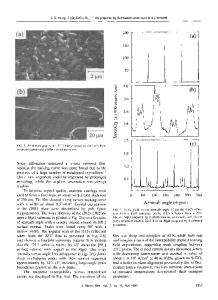Influence of Starting Material on Bi 2 sr 2 cacu 2 o 8 Fibers Grown by the Float Zone Process
- PDF / 1,160,179 Bytes
- 5 Pages / 420.48 x 639 pts Page_size
- 34 Downloads / 327 Views
INFLUENCE OF STARTING MATERIAL ON Bi2Sr2CaCu2O8 FIBERS GROWN BY THE FLOAT ZONE PROCESS
LINDA V. MOULTON AND JOSEPH M. BRENNER, Material Science Department, Stanford University, Stanford, CA 94305 ROBERT J. RAYMAKERS, PERLA N. PESZKIN AND ROBERT S. FEIGELSON, Center for Materials Research, Stanford University, Stanford, CA 94305
ABSTRACT A miniaturized float zone technique using laser heating has been found to have potential for producing superconducting fibers of Bi2Sr2CaCu2O8 which can carry high currents. Growth stability and growth rate, however, need to be improved if this technique is to be useful for preparing long lengths of 30 ýtm diameter high quality fibers for property evaluation and prototype devices. One of the first requirements toward achieving this goal is the preparation of dense, homogeneous starting material. Work on different strategies for starting material preparation are discussed.
INTRODUCTION The use of the laser-heated, miniaturized float zone process for the growth of fibers of a wide variety of oxide materials has been discussed by Feigelson.(1) This method has 23 recently been shown( , ) to also be useful for growing fibers of the Bi2Sr2CaCu2O8 high Tc superconductors, in part because it is containerless process and suitable for the growth of incongruently melting materials. The high thermal gradients inherent in this process (> 10000 C/cm) help stabilize the growth interface and permit higher growth rates. The method can also be used to determine important features of the phase diagram relevant to 4 understanding the growth behavior.( ) The effect of growth atmosphere and the influence of growth rate on the structure and properties of Bi2Sr2CaCu2O8 fibers grown by this method has been described by Gazit et al.(-). They found that growth rates above 10 mm/hr yield multiphase fibers with poor superconducting properties. Post growth annealing restores Tc values to that of slow grown single phase fibers. An air or slightly 02 enriched atmosphere during growth was found to yield good superconducting properties. One of the primary goals of this research is to adapt the laser-heated float zone process to the growth of long, flexible, 30 ýtm diameter fibers of the Bi-based high Tc superconductors which can carry high currents. In order to accomplish this, an understanding of the influence of starting material composition and processing parameters on growth stability and growth rate is critical to the success of this program. The quality of starting material (density and homogeneity) is the first problem that must be addressed before reproducable results can be achieved.
Mat. Res. Soc. Symp. Proc. Vol. 169. @1990 Materials Research Society
292
EXPERIMENTAL Details of the fiber growth method and experimental apparatus were given by Feigelson.( 1) A schematic of the growth process is shown in Fig. 1 along with the critical parameters involved. In this illustration, the source material is on the bottom and the fiber on top. Because it is not possible at this time to fabricate suitable sourc
Data Loading...











